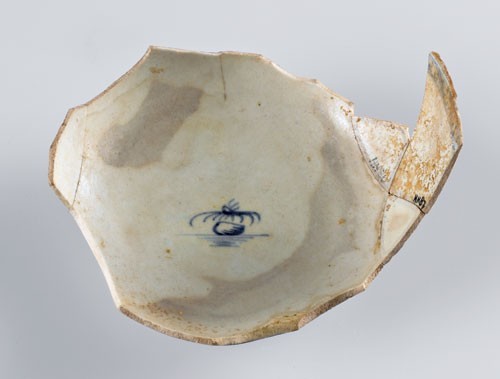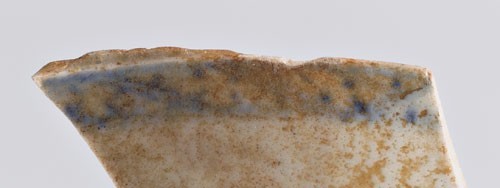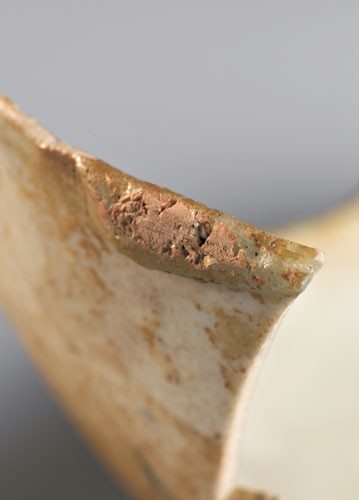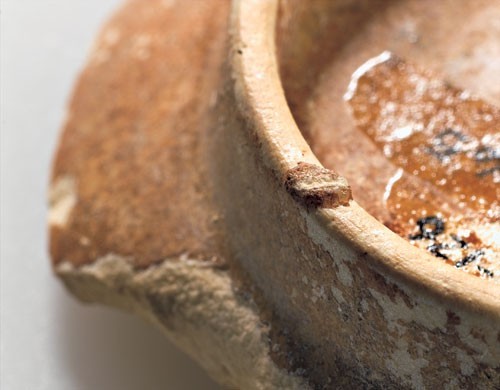
Waste or slop bowl, American China Manufactory, Philadelphia, Pennsylvania, 1770–1772. Soft-paste porcelain. (Courtesy, Atwater Kent Museum; photo, Gavin Ashworth.)

Bottom view of the bowl illustrated in fig. 1, showing the “P” mark.

Interior view of the bowl illustrated in fig. 1.

Detail of the interior rim of the bowl illustrated in fig. 1.

Detail of the glassy glaze flaw on the rim of the bowl illustrated in fig. 1.

Detail of firing flaw on the footrim of the bowl illustrated in fig. 1. The small residue is where the bowl sat on the kiln furniture during firing.
This previously unpublished example of a Bonnin and Morris slop or waste bowl is in the collection of the Atwater Kent Museum, Philadelphia (fig. 1). It was excavated by archaeologist Barbara Liggett in New Market, Philadelphia, the area east of Second Street and between Pine and South streets about 1980. The bowl was found in a brick-lined pit, Area 5b, Feature 29, which was interpreted as a privy, a feature common in the backyards of eighteenth-century Philadelphia lots. In 1743 the property had been purchased from Samuel Powell by Richard Bailey, who built a frame house fronting the property and a brick structure behind the house. (Both survived well into the nineteenth century.) The brick privy is thought to have been original to Richard Bailey’s ownership. In 1769 the property was sold to Philip Flick, who is the most likely candidate for ownership of the waste bowl.[1]
The slop or waste bowl was one of the essential forms constituting an eighteenth-century tea set. By mid-century these small bowls were standard equipage for the preparation and serving of tea, used to collect the dregs from a teacup before the cup was refilled.
Waste bowls appear among the other tea ware known to have been made at the Bonnin and Morris factory in the May 10, 1771, purchase by Thomas Wharton, a Philadelphia merchant. Listed among the tea-related wares he purchased—handled cups, sugar dishes, cream ewers, and teapots—is an entry for “Foure Bowls @2/6.” Although not specifically identified as waste bowls, their association with tea-related items and the fact that they were the least expensive items indicate their intended function.[2]
The excavated bowl is decorated on both sides with Chinese landscapes (fig. 1) similar to those on documented Bonnin and Morris sauceboats (see Plate 1). Unfortunately, much of the overall composition is missing. The bottom is marked with the familiar underglaze “P” (fig. 2); the interior is decorated with a simple rock-and-plant motif (fig. 3). The presence of interior decoration helps confirm that this bowl functioned as an open waste bowl and not as the base to a covered sugar dish. The interior rim is decorated with a dotted diamond border (fig. 4) similar to the one painted on the Philadelphia sauceboat (see Plate 1).
Most interesting about this bowl are the telltale signs of firing flaws, which certainly should have relegated this object to the status of a “second’ if not an outright reject. On the rim is a disfiguring glob of greenish glaze that clearly compromises the bowl’s aesthetic quality but not its function (fig. 5). On the bottom footrim is a small point of contact with the kiln furniture where the bowl adhered (fig. 6). Given these flaws, one might wonder how the object came to the Flick household. Was it purchased as a “second” or acquired as a sample? Or was it perhaps simply a souvenir from one of the early kiln emissions?
We may never know the circumstance of how and why this waste bowl ended up in the privy of Mr. Flick, but even with its flaws, this seemingly unremarkable bowl represents a form known only from historical records and therefore serves to enhance our understanding of the full range of the products and decoration of the American China Manufactory.
Barbara Liggett, Archaeology at New Market, Excavation Report (Philadelphia: N.p., 1981), pp. 74–76.
“The Bill of Thomas Wharton May 10, 1771,” Pennsylvania Magazine 33 (1909): 253. For a reprint of this bill, see Graham Hood, “Bonnin and Morris of Philadelphia: The First American Porcelain Factory, 1770–1772,” p. 58, Appendix 7, in this volume.
